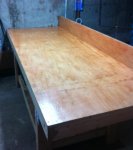Hi All,
Looking to build a work bench for the shop and was hoping to get some idea from others who already have built one or work someplace that has one and wishes it was laid out different. The work bench will be used for all type of service work such as soldering cables as well as servicing and bench testing equipment such as power amps and moving light fixtures such High End DL3's. Looking for things like width, length, depth. Surface top? Straight or L shaped? Just trying to avoid mistakes want to make it as functional as possible.
Thanks in advance!
Bill
Looking to build a work bench for the shop and was hoping to get some idea from others who already have built one or work someplace that has one and wishes it was laid out different. The work bench will be used for all type of service work such as soldering cables as well as servicing and bench testing equipment such as power amps and moving light fixtures such High End DL3's. Looking for things like width, length, depth. Surface top? Straight or L shaped? Just trying to avoid mistakes want to make it as functional as possible.
Thanks in advance!
Bill


